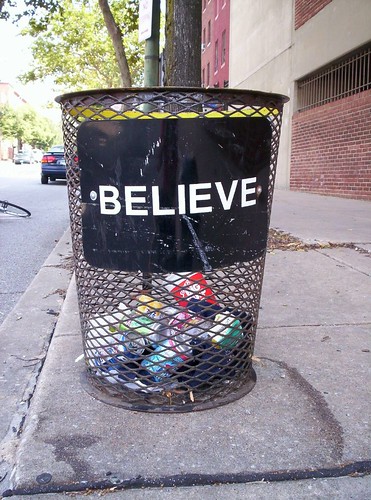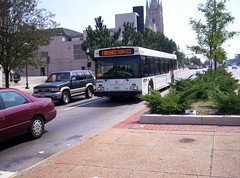Baltimore and bicycling
 My bike wheel is in the left of this Baltimore photo from last July. Also see "Getting to Baltimore (and Artscape) with a bike."
My bike wheel is in the left of this Baltimore photo from last July. Also see "Getting to Baltimore (and Artscape) with a bike."I thought I was done with Baltimore today but somehow I missed a January article about a bicycling development plan for the City of Baltimore, which is discussed in this blog entry from WashCycle, "Baltimore Throws Down the Gauntlet." The original Sun article, "Bike lanes on path to approval ; First step in $175,000 plan would link Baltimore's college system" from January 23rd, 2006, is no longer available online, but the magic of databases allows retrieval:
Ambitious plans to create a bicycle network across Baltimore with a combination of designated lanes and shared roadways spanning more than 400 miles could begin in about a year, pending approval by the city's planning commission. The idea is to allow bicyclists to more easily navigate the often- congested streets by adding markings and signage, and, in some cases, resurfacing roadways to make them smoother. The paths would be integrated with public transportation stops.
Planning officials said at a meeting last week that the first phase would be the creation of the Collegetown Bike Route, which would link Johns Hopkins and Morgan State universities with St. Mary's Seminary and the Loyola-Notre Dame campus. Construction could start in about a year and cost $175,000.
The entire project could take up to 20 years to complete. It would include adding bicycle racks across the city and an education campaign for motorists and cyclists on how to safely share city streets. Promoters said they hope to get more people riding bicycles to work and when running daily errands.
"Baltimore has a lot of strong neighborhood shopping," said Robert S. Patten, a senior planner at Toole Design Group, which the city hired to develop the plan. "Biking's a great way to get access to all these things." Patten, who has spent a year on Baltimore's project, worked on plans for bike networks in other cities, including Washington. He is also a cyclist, and he listened to fellow enthusiasts at a public forum and spent time biking around the city and brainstorming with city officials to create a plan that would work best for Baltimore.
At last week's meeting, attended by about 100 people, city planners presented census statistics showing that less than one- half of 1 percent of Baltimore residents commute to work on bikes, compared with more than 1 percent in Washington.
"Baltimore is really struggling to become a world-class city, and this is really a forward-thinking idea, building a bike-friendly city," said Mike Counselman, a board member for One Less Car, a statewide biking advocacy group and a member of the mayor's Bicycle Advisory Committee.
"This is really about quality of life, revitalizing neighborhoods," he said. "When you think about why people want to live in the city, they want access to neighborhoods."
Ian Macdonald treks to work each day on a mountain bike from his Riverside Park home in South Baltimore to his downtown office, saving money in an era of high gasoline prices. He's commuted this way for years.
His route isn't always easy. The 30-year-old takes Key Highway, a wide and winding street that skirts an industrial zone and high- priced developments under construction, in which he constantly has to dodge potholes, sewer grates and impatient drivers.
Macdonald wears a helmet and has 15 years' experience biking in urban areas, yet Baltimore's lack of designated street lanes and what he describes as a culture of disdain for bicyclists make his trip decidedly stressful.
"One of the biggest problems I have is because it's not a designated bike trip, you find a lot of trucks in those lanes," Macdonald said. "And you have to jump out into four lanes of city traffic." But the climate seems to be improving. Macdonald, who three years ago successfully lobbied his employer, Constellation Energy, to install a bike rack outside his office building, said he now struggles to find a place on the rack to park his bike.
"It's about infrastructure - making sure you have connections to the light rail system and buses and MARC," Macdonald said. "I would love to be able to bike to the MARC station and go wherever I need to go."

No bike rack on this MTA bus. Photo from last July. Plus, you can't take bikes on MARC Trains.
Index Keywords: bicycling



0 Comments:
Post a Comment
<< Home